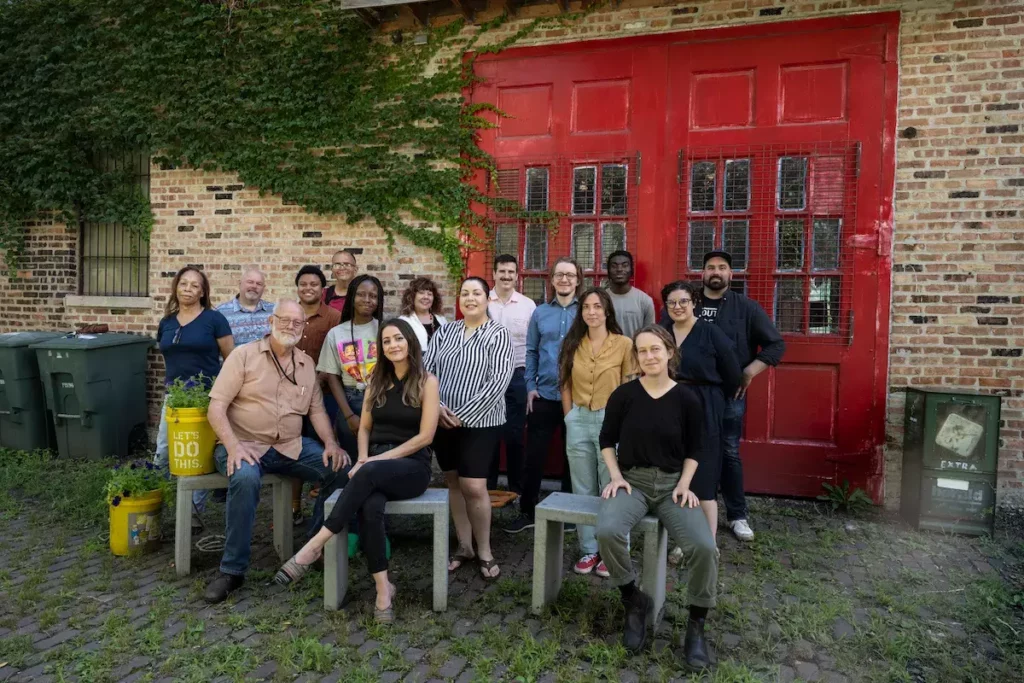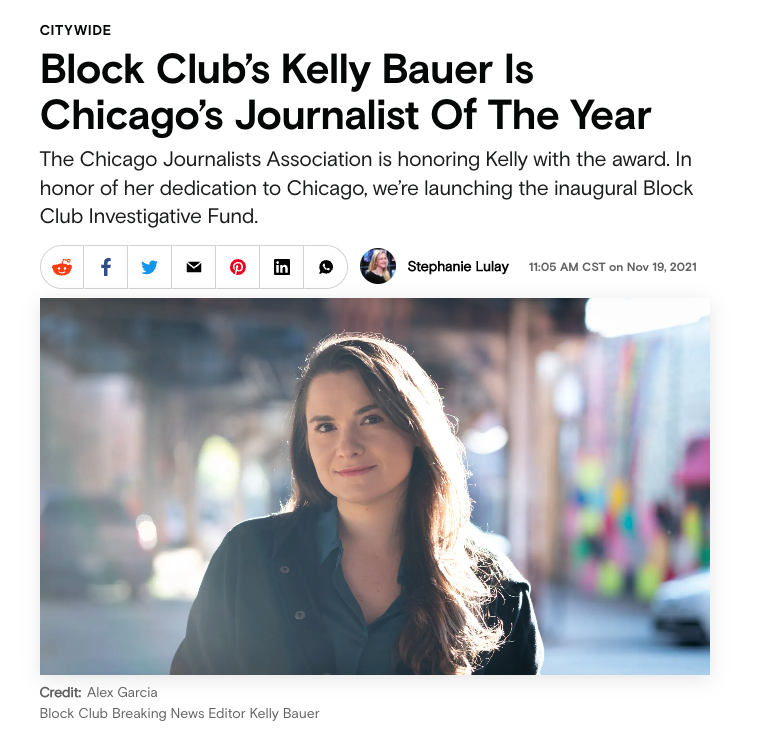How to talk to your audience about expansion
By Sam Cholke, Manager of Distribution & Audience Growth, INN
December 15, 2022
Last year, the South Side Weekly faced a dilemma. It needed to expand — to increase hours and wages for staff and also to bring more people on board to work with community members on collaborative reporting. Leadership needed to thread a fine needle: how to convert more of its one-time donors into recurring donors through a membership program without promising anything more from an already stretched newsroom staff.

It’s a dilemma many INN member newsrooms face. They have worked hard to establish a relationship with their audience and built expectations over time of the work the newsroom does and how its audience will support that work. But expanding into new reporting areas or styles will disrupt those expectations and relationships. On a more fundamental level, like at South Side Weekly, the organization may need increased support from its audience in ways largely invisible to most readers.
An expansion is always a risk. Newsrooms want to grow to better serve their communities, but don’t want to jeopardize the service they provide to part of a community in pursuit of a different part.
When evaluating an expansion plan, audience research is not as simple as giving the readers what they say they want. In modern newsrooms, success comes when the interdependent pieces of the organization add to each other and increase the overall strength of the whole system. Audience is not the only piece, but audience success is a critical ingredient for everything else.
The Institute for Nonprofit News (INN) examined how three newsrooms in the INN Network understood existing and potential audiences when creating an expansion strategy. While the methodologies were often similar, each newsroom was considering a plan that would serve their communities in dramatically different ways and with varying levels of visibility for the audience, which could potentially impact reader revenue.
The newsrooms
Montana Free Press’ expansion would be the most visible to its audience. The three-year-old newsroom was considering an expansion that would add a significant amount of regional coverage around the state from many new reporters. It would be both highly visible to existing audiences and potential new audiences with a considerable amount of new reporting available on topics that built on its core politics and policy reporting from the state’s capitol.
Block Club Chicago’s strategy was less visible. The newsroom’s approach of hiring reporters to cover specific neighborhoods of Chicago means each geographic expansion is most visible to those living in a specific place. The newsroom was weighing whether to more aggressively pursue geographic coverage or to add specialized reporting that might be more visible across the city.
The South Side Weekly’s plan would be the least visible to the regular readers of its website and bi-weekly newspaper. Devoted to a mission of journalism that is highly collaborative with the communities it serves, the newsroom has relied heavily on volunteers during its first eight years. But it had matured to a point where it needed to professionalize its editorial and operational staff if it was to continue to grow.
Internally, each organization felt it understood how an expansion built on its existing work and related to its core mission. Each took on audience research in part to understand how well its audience understood the organization’s mission and how best to expand to ensure audiences saw the expansion as supporting that mission.
How they did it
All three newsrooms took four key steps to understand how an expansion would impact their relationship with their audience and potential new audience revenue.
Each newsroom started its assessment of a proposal with research. They took the time to understand who their existing audience was and how they were best serving them. They performed small tests to assess how an expansion would impact their ability to serve their core audience. All had extensive audience conversations to better understand how an expansion would build the best associations with their brand. Finally, each newsroom took time to specifically test audience revenue opportunities before committing to the proposal or any other sources of revenue it could bring.
Articulate the opportunity
A newsroom’s audience is much more complex than a few Google Analytics data points. Estimates about age or location are helpful, but whether someone lives with school-age children and is very invested in school coverage is much more valuable. All the newsrooms examined spent considerable time early in the process building a profile of their core audience segments and researching how many more people that matched those profiles were out there.
For John Adams, executive director and editor-in-chief of the Montana Free Press, building profiles was crucial to picking the markets it would test first for an expansion into more local coverage around the state.
“We’ve got strong growth in audience in places like Helena, Missoula, Bozeman, but it’s still just a fraction of what’s available there,” said Adams. “So our attitude was, as the Lee Enterprises and other major dailies that were serving those communities continue to shrink their newsrooms, we would start to pick up the slack.”
He said the Free Press first narrowed its options to places where there was some brand recognition already and there was a comparatively large population of people with a diverse range of incomes living close together.
“So the audience strategy was meant to both expand the sheer number of eyeballs on the content but create more opportunities for us to convert those eyeballs into newsletter subscribers and then membership,” Adams said.
The Free Press worked with News Revenue Hub to conduct a relatively straightforward survey asking its existing audience how they used and felt about the Free Press’ existing products and including demographic questions that matched U.S. Census and other population data the Free Press had access to. From there, Adams and the staff were able to look across the readership and construct profiles that described the largest segments of its most loyal audience, where they lived and how they used the Free Press.
With profiles in hand, the Free Press understood who their reporting and products were most appealing to and identified four test markets where the Free Press had the most potential — and some traction already.
Critically, the profiles articulated an opportunity before any experimentation started. Adams knew who the Free Press was good at serving already, and how many people like that lived in each market, and he could then create realistic metrics and goals to measure the success of any experimentation.
Try it
All three newsrooms threw spaghetti at the wall. Trying something at a small scale was the most cost-effective way to research how an expansion could grow the news organization’s audience.
Block Club Chicago leveraged collaboration within the INN Network to its benefit when testing expansion opportunities. The newsroom republished more education coverage from Chalkbeat and local politics coverage from the Daily Line to understand how more topic-based coverage would perform compared to its neighborhood stories. Block Club also actively took on more collaborations in spaces where there were opportunities to expand, particularly around investigations, with Co-Executive Editor Stephanie Lulay leading partnerships with ProPublica, Better Government Association and other newsrooms.
Publisher Shamus Toomey said the idea was never to replace any partners, but to understand both where there was pay off in adding capacity to produce more journalism and to expand partnerships further. The direct intention was also to evaluate how the organization would manage an expansion.
“It gets more complicated as you grow because you add five new reporters, it’s not just five new reporters, you’re going to need an extra editor,” Toomey said “At some point you’re going to need an H.R. department. You need to know if you’re going to outgrow the legal stuff — five more reporters, five more things to pay lawyers for.”
Block Club evaluated the potential audience revenue it could generate as it also tested the costs. It could cover areas that motivated its audience, but if the indirect costs were too high to maintain, it would be a net loss over time. So before making any promises or offers, it tested the organization’s ability to incorporate that expansion.
“You have got to be careful that as you expand you’re not taxing the existing structure,” Toomey said. “I think what we’ve kind of realized now is that we’re at the point where expansions need to happen within the office.”
He said those expansions are much more challenging because it can be much more difficult to motivate readers to donate for operations compared to an investigations team.
Branding and messaging
Each newsroom embarked on extensive conversations with their audience about their expansion plans and made them focus as much on the brand as the immediate project.
The South Side Weekly worked with Chicago nonprofit Public Narrative and Northwestern University to be systematic in how it talked to its audience about its expansion plans. (Full disclosure, the author administered the Weekly’s survey.)
The Weekly is part of a growing movement within journalism to find new ways to include communities in the reporting process. While this collaborative style is well known and distinctive within the industry, it was unclear whether the difference in approach was understood or valued by the Weekly’s readers. Brand associations were particularly important for Managing Director Jason Schumer because the weekly needed its audience to donate more and more often so it could support an internal expansion to a more professional staff.
Schumer said he went into focus group sessions and surveys focused on whether readers understood the Weekly’s mission and if the mission was enough to motivate them to participate in a new membership program.
“It was super helpful. It was really clear that the majority of people felt like membership models made sense for us and they believed in that model, which felt a little bit unexpected to have such clarity,” Schumer said.
The Weekly’s audience is mostly younger people of color on the South Side of Chicago. Previous surveys by Northwestern University had shown that young people on the South Side in particular were very averse to paying for news, and the larger cultural view was that news should be free for everyone. The focus groups and a follow-up survey with Weekly readers, however, found that, although the newspaper was distributed for free across the South Side, the overwhelming belief among readers was that those who could afford to pay, should.
After hearing from their audience that the South Side Weekly’s brand was best represented by its work with South Side artists, the newsroom is working on new projects, like a profile and T-shirt designed by Kahari Blackburn, to explore out how to incorporate it’s work with artists into a new membership program.
For Schumer, this showed that the Weekly had already overcome one of the largest hurdles. People already understood its mission and how it was different from other news organizations and it had successfully shifted them from the attitude that news should be free. Just as importantly, Schumer left the focus groups and surveys with a sense of what about the Weekly’s work best represented its community mission.
“We asked people what they wanted [as a perk of membership] and we got a lot of interesting answers,” Schumer said. “I think one of the most common responses was original art created by outside artists that work with us, which made a lot of sense. It fits into the broader model in the way that we approach this work — by supporting the South Side Weekly, you’re supporting South Side artists.”
Schumer said he immediately tested this to see if it was more than talk and as part of its NewsMatch campaign included a new appeal that was its most direct — if you share our values, the Weekly needs your support now. The campaign immediately got 25% more support than past efforts, according to Schumer. He said he understood then the critical messaging for expansion was not to sell what the Weekly was, but that it needed support.
“That was really kind of eye-opening and that honestly the most effective asks are just really direct and not overly complicated. And that’s remained true,” Schumer said. “You’ve got to ask people a lot of times before they do it. I’m always nervous that we’re annoying people, but it’s clear that even with the number of solicitations we send out at the end of the year, there were still people saying they didn’t know that we needed support.”
Experimentation
Schumer had the same anxieties that all three newsrooms did — that audiences would say they would support an expansion and then wouldn’t donate when the ask finally came. All three newsrooms still sent up trial balloons after their audience research. Readers aren’t obligated to do anything when saying they would support something in a survey, and it was important to all these newsrooms to understand whether that would translate into action.
Block Club Chicago’s strategy was the most direct and ensured that the audience revenue would be there before it pursued any other revenue.
“We started an investigative fund,” Toomey said. “We had a couple of different ways of testing to see the appetite out there for it, including, ‘Would you support this investigative fund?’” Toomey said. “We tied it to Giving Tuesday, part of one big donation day, and I remember it was upwards of $10,000 raised in a day. So the appetite was definitely there.”
The benefits went well beyond $10,000. Block Club was able to collect information on how the expansion would affect donor habits. Toomey and the team could look and see if that campaign brought in more first-time donors, re-engaged past donors or convinced existing donors to give more. Block Club had a better view not only of how an expansion would affect readership, but also how it might affect donation habits.

Toomey said it was a benefit to have unrestricted funds from the campaign supporting the expansion before they pursued restricted funds from a foundation or major donor.
“Investigations also open up not just more foundation doors, but also the people in Chicago that care about good government and that will support investigative journalism because they love their city,” Toomey said. “And they know that this is Chicago and there’s always somebody up to no good. The more reporters, the better.”
How you can do it
For all three newsrooms, the audience research they did to explore an expansion was much broader than looking into the specific proposal being considered.
They started by building a profile of their audience to understand who they were currently serving well and where there was an audience already familiar with their brand and how it was different from other news sources.
Each did small-scale experiments to understand how an expansion would affect their ability to serve their core audience.
All the newsrooms talked to their audiences extensively through multiple channels. The most effective started by understanding first how their brand was perceived by their audience and how an expansion could play to the brand’s strengths.
Finally, each newsroom tested the audience revenue before committing to other revenue. At its best, this step informed the newsroom how not just reading habits, but donation habits would be impacted by an expansion.
Audience research is a critical component of any expansion strategy and should effectively assess how a proposal would integrate into the larger view of the brand, impact audience and donor habits and balance the opportunities and costs.
Over the next year, INN will dramatically expand the amount of resources available to members that want to conduct similar research on their own audiences. This includes templates for surveys like these newsrooms used, as well as assistance from INN staff in analyzing the results. There are significant opportunities to incorporate audience research into NewsMatch and other campaigns and INN will host more training sessions over the coming year about how audience research can inform fundraising.
Expanding audience opportunities and services will be communicated to members and listed on the web site in early 2023.
This case study was made possible with support from the Google News Initiative, as well as INN’s general support funders.
